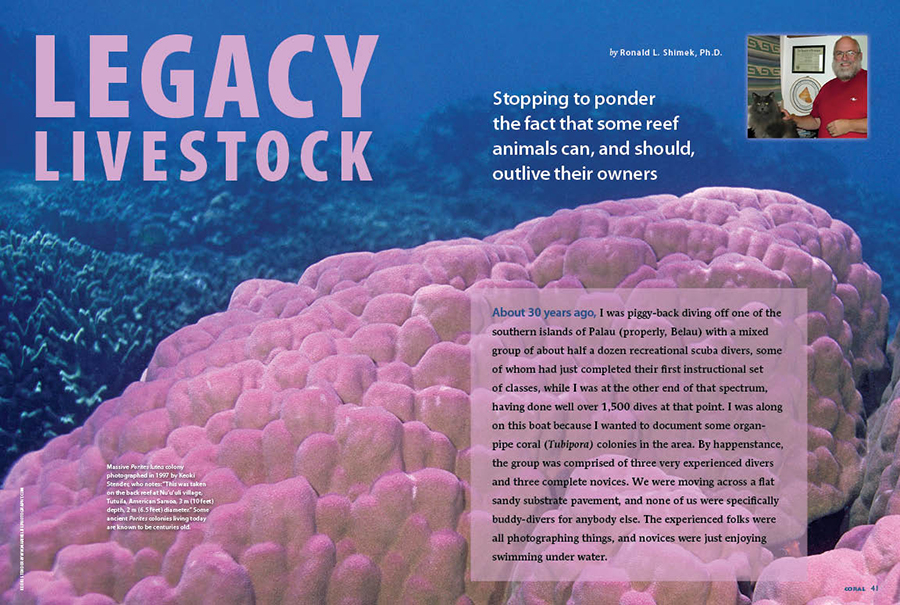
Stopping to ponder
the fact that some reef animals can, and should, outlive their owners
by Ronald L. Shimek, Ph.D.
CORAL Magazine, Jan/Feb 2023
References
Botting, J. P., & Muir, L. A. (2018). Early sponge evolution: A review and phylogenetic framework. Palaeoworld, 27(1), 1–29. doi:10.1016/j.palwor.2017.07.001
Díaz, M.C., Nuttall, M., Pomponi, S., Rützler, K., Adams, C., Hickerson, E., Schmahl, G. and Klontz, S.W., 2022. An annotated and illustrated identification guide to common mesophotic reef sponges (Porifera, Demospongiae, Hexactinellida, and Homoscleromorpha) inhabiting Flower Garden Banks national marine sanctuary and vicinities. ARPHA Preprints, 3, p.e94515.
Dufour, S.C. and McIlroy, D., 2018. An Ediacaran pre-placozoan alternative to the pre-sponge route towards the Cambrian explosion of animal life: a comment on Cavalier-Smith 2017. Philosophical Transactions of the Royal Society B: Biological Sciences, 373(1738), p.20170148.
Fahey, B. and Degnan, B.M., 2010. Origin of animal epithelia: insights from the sponge genome. Evolution & development, 12(6), pp.601–617.
Freeman, C.J., Easson, C.G., Fiore, C.L. and Thacker, R.W., 2021. Sponge–microbe interactions on coral reefs: multiple evolutionary solutions to a complex environment. Frontiers in Marine Science, 8, p.705053.
Jaakkola, S.T., Pfeiffer, F., Ravantti, J.J., Guo, Q., Liu, Y., Chen, X., Ma, H., Yang, C., Oksanen, H.M. and Bamford, D.H., 2016. The complete genome of a viable archaeum isolated from 123‐million‐year‐old rock salt. Environmental microbiology, 18(2), pp.565–579.
Jaakkola, Salla T., Ravantti, J.J., Oksanen, H.M. and Bamford, D.H., 2016. Buried alive: microbes from ancient halite. Trends in microbiology, 24(2), pp.148–160.
Jochum, K.P., Schuessler, J.A., Wang, X.H., Stoll, B., Weis, U., Müller, W.E.G., Haug, G.H., Andreae, M.O. and Froelich, P.N., 2017. Whole‐Ocean Changes in Silica and Ge/Si Ratios During the Last Deglacial Deduced From Long‐Lived Giant Glass Sponges. Geophysical Research Letters, 44(22), pp.11–555.
Jochum, K.P., Wang, X., Vennemann, T.W., Sinha, B. and Müller, W.E., 2012. Siliceous deep-sea sponge Monorhaphis chuni: A potential paleoclimate archive in ancient animals. Chemical Geology, 300, pp.143–151.
Kahn, A.S., Chu, J.W. and Leys, S.P., 2018. Trophic ecology of glass sponge reefs in the Strait of Georgia, British Columbia. Scientific Reports, 8(1), pp.1–11.
Kise, H., Montenegro, J., Santos, M.E., Hoeksema, B.W., Ekins, M., Ise, Y., Higashiji, T., Fernandez-Silva, I. and Reimer, J.D., 2022. Evolution and phylogeny of glass-sponge-associated zoantharians, with a description of two new genera and three new species. Zoological Journal of the Linnean Society, 194(1), pp.323–347.
Leys, S.P., 2007. Sponge coordination, tissues, and the evolution of gastrulation. Porifera Reserach: Biodiversity, Innovation and Sustainability. Custodio M, Loˆ bo-Hajdu G, Hajdu E, & Muricy G, eds, pp.53–59.
Renard, E., Bivic, A.L. and Borchiellini, C., 2021. Origin and evolution of epithelial cell types. In Origin and evolution of metazoan cell types (pp. 75–100). Boca Raton: CRC Press.
Wang, J., Chen, D., Yan, D., Wei, H., & Xiang, L. (2012). Evolution from an anoxic to oxic deep ocean during the Ediacaran–Cambrian transition and implications for bioradiation. Chemical Geology, 306–307, 129–38. doi:10.1016/j.chemgeo.2012.03.005 10.1016/j.chemgeo.2012.03.005
Xiaohong, Wang; Schröder; Müller, E.G. (2009). “Giant Siliceous Spicules from the Deep-sea Glass Sponge Monorhaphis chuni”. In: Jeon, Kwang W. (ed.). International Review of Cell and Molecular Biology, Vol. 273. London: Academic. pp. 69–115. ISBN 978-0-12-374804-1.




